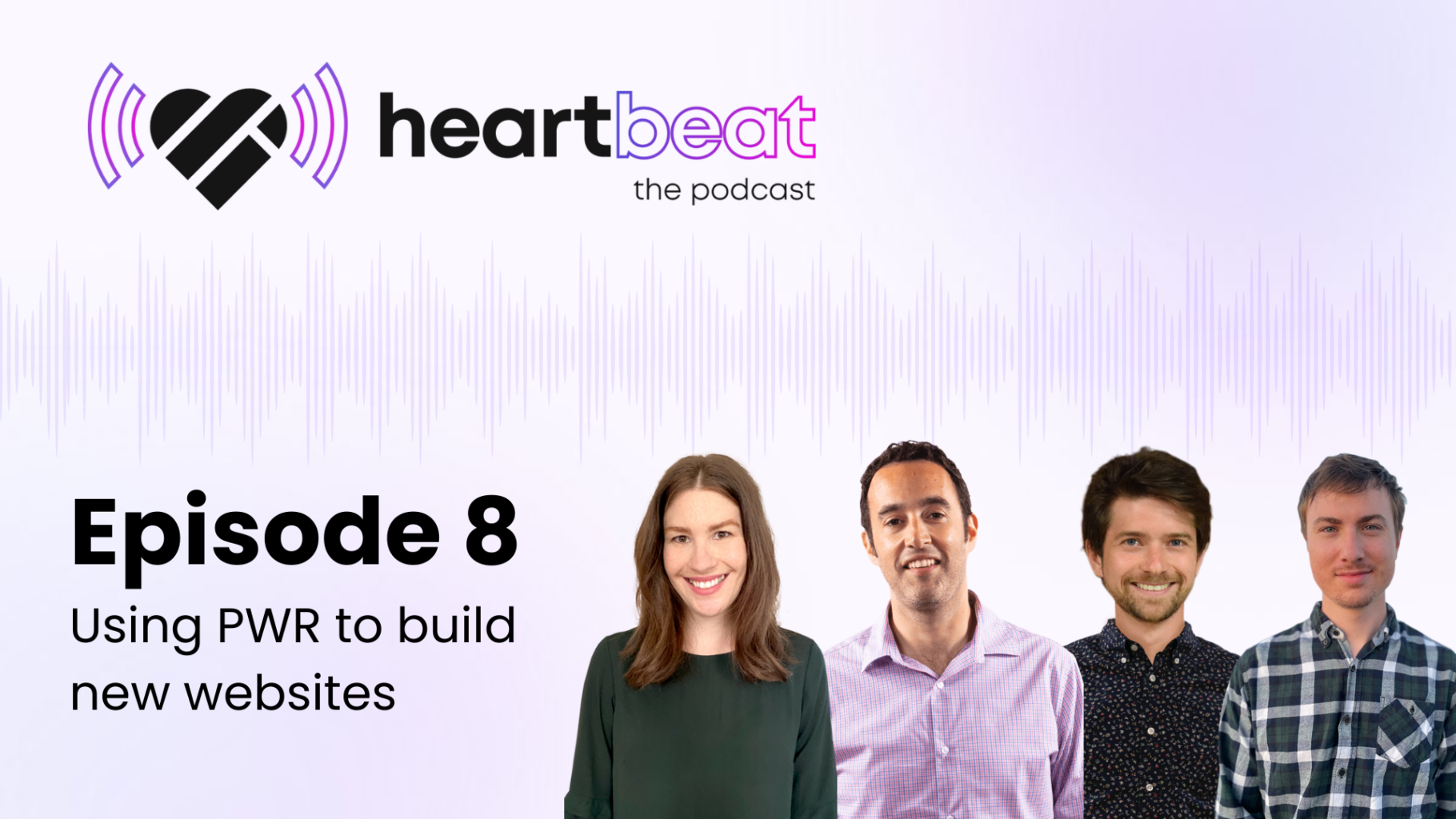In this episode of the Heartbeat Podcast, Conor, Andrew, Peter, and Lauren chat through some more details on our innovative approach to website development called Progressive Website Replacement (PWR).
PWR advances some of the more traditional methods by allowing businesses to incrementally replace their websites instead of launching a completely new site all at once. This phased approach reduces risk, maintains business continuity, and offers flexibility to adapt to changes throughout the development process.
We chat through the benefits of PWR, such as mitigating the impact on business operations, allowing for real-time adjustments, and easing the financial burden by spreading costs over time. We also dive deep into why PWR is especially advantageous for large organizations with complex requirements, enabling them to keep their digital presence up-to-date without overwhelming stakeholders or disrupting ongoing operations.
Listen below for some practical advice on adopting the PWR process–and get in touch if you’re interested in implementing for your next web build.
Transcript below:
Conor Snell: Hey everyone, you’re listening to the Heartbeat Podcast with Digital Impulse. I’m Conor Snell. We’ll go around the horn with intros.
Andrew Kolidas: Andrew Kolidas.
Peter Modest: Peter Modest.
Lauren Allen: Lauren Allen.
CS: Awesome. Thanks guys. How was everyone today?
AK: Oh, just peachy, man. Weather’s turning. Couldn’t, can’t complain. How about yourself?
CS: Same. It’s great. I love the springtime.
LA: Yeah. Doing good.
AK: Now that we’ve gotten that out of the way, nice. This is our best intro ever. I just want to make note of that for all you listeners out there. We just crushed it. So buckle up.
CS: Episode over. We’re done. Awesome. Cool. Thanks guys. I thought today would be a good time to talk about our newly rolled out power process, PWR—Progressive Website Replacement. That’s a new framework that we have for building websites, a different way than most companies might be used to. Just like a less traditional way that involves some more innovation and changes the game for how a site can be built.
So I figured it’d be a good time to get everyone together and chat about it. Andrew, you want to kick us off? What is PWR and how does it change the game for creating a website?
AK: Great question, Conor. PWR, Progressive Website Replacement. I want to make a note that Peter named it. We were very specific about the naming. We were first using Website Replacement Therapy,
which is catchy but a little weird. Progressive Website Replacement is what it sounds like. Instead of just going in a lab and creating a new website and launching one day, it’s getting that end product, that new website you need, but replacing a current website in batches, but not just the front end. We’re talking the entire architecture of the back end of the site.
We found that a lot of clients that are building upon their current website are just making it worse and worse and more cheugy, multiple vendors, multiple programmers jumping in until you have this website that is manageable so they want the new website, but they also don’t want to wait for the final product They need impact now They need to launch a new brand telling new message to keep their business healthy So at PWR does is bridge the gap between giving you that new website you need but also having the short -term impact of Really helping your business grow
CS: So you mentioned building a website in phases. What does it mean, Peter, maybe you could have to find how that’s different from a traditional web build and what do we mean when we say build it in phases?
PM: Yeah, for sure. So I think traditionally, kind of as Andrew was mentioning, you’re expecting a full design process approaching every page on the site and really approaching the entire thing holistically all at one time with the intention of on a single launch day putting all of this new content out to the world. We will strategize with a client to componentize the site. We say what are key pages that really need work right now?
Maybe it’s the about page, maybe it’s location pages in general. So, what we do is we start to create a schedule that has many different launches leading to a time in which the entire site is replaced and you have this new launched website.
CS: Awesome. I mean, that’s huge for a business who knows they need a new site, but maybe they’re a little intimidated by going to the lab for six months and then come out and we have a fully new site and everything that comes with that. Obviously, there’s risk that comes with launching a completely new site with completely new content. How do we think about the benefits of PWR versus a traditional web build? Why would an organization choose a phased approach to a site? What does that offer versus a or traditional build?
LA: I think you hit the nail on the head, Conor. I know in our article that we released, there are several points. So I think from my perspective, having had conversations with clients and working in this platform, the two that I like the most are reducing the risk.
So being able to do it incrementally instead of at one time, we have many clients where lead capture and forms are a big part of their business. So if we were to release a website all at once and for some reason it did not perform as strongly and conversion rate dropped, that’s a big risk to their business and their needs. So being able to do it page by page or section by section and really monitor that performance is I think a critical point for a lot of businesses.
The other thing for companies that aren’t so focused on the business impact or lead gen, but they are trying to make an impact in brand or repositioning, it allows them to do it incrementally without taking off, thinking about 100 % of the project out of the gate so they can focus on the homepage, the about us, their services section and really do it piecemeal or a bite size, if you will, that is more digestible for them to focus on and create that impact. And that kind of also allows testing into new messaging and branding, right?
So they can gauge how things are going along the way and pivot if they need to. If they realize something isn’t working, it doesn’t have to be that one time fix.
They can release a homepage, monitor it and tweak and tweak it a week or a few weeks later without it being this big impact.
AK: Yeah, a couple other things I wanna flag too because we work a lot with CMOs, marketing directors. Sometimes we’re working people in design, sometimes it’s technology, a lot of different POCs. They often report up to the C -suite and when you wanna get a new website project going, you have to go out to RFP, you have to pick an agency, it’s this long process.
Usually, the C -suite’s pretty burnt out by the time the website even starts. And within a month, they’re like, so how’s the website? And time moves fast.
And after two months, they start to get impatient. “Well, I haven’t seen a new website. I haven’t seen anything happen.” Of course, it’s like a, could be a five, six month project.
What PWR does is allow our POCs to maintain the excitement with the C -suite on the new project build. “Oh, this week, we’re releasing the navigation. This week, we’re releasing a new homepage.” They’re almost following the journey. That’s one thing I want to flag. Our POCs have loved this process because they get way less questions and they get the now impact on a lot of their business metrics.
Another under the radar thing, as well as budgeting. It’s hard to go into marketing directors, go in and request budget.
Everybody’s being a little cost conscious in this past year especially, instead of going and saying I need a 150 ,000 for a website, I need 250 ,000 for a website. Whatever type of site you’re looking for, you’re getting a lot more “nos” but will management approve a 10K a month, 15K a month website retainer? Yeah, they will. It’s a much more digestible ticket item. And we could easily say with confidence that it will pay for itself because we’re gonna make some great improvements to your website, use it to help grow your business, and the project will literally pay for itself.
Now, is that guaranteed? Of course not, but that’s how we truly feel about the process.
PM: Yeah, I’d also like to tag on a couple more use cases. I think there’s, when a client needs to build a new feature for a website, and they really don’t want to add onto the existing antiquated infrastructure, this allows us to create the new infrastructure, which will eventually contain the entire website, It allows the client to put this new feature into a place where they’re not sinking further into tech debt.
So I think that’s a really, really important use case for certain clients. The other one is clients that have an issue with their current messaging on their site. They’re really in need of redoing the content on the site, but there’s just so much content. So this allows the client team to start tackling the site in blocks once again to Andrew’s point, maintaining the excitement for the project because sometimes it can take a year to really rewrite the content for a site if there are potentially thousands of pages.
CS: Totally, totally. And to Lauren’s point, the ability to test out that messaging on a page by page or section by section like to test a new navigation or test a new homepage and get that buy -in from people internally before you’ve launched the entire site is not only better for internal processes, but then you have a foundation to build the rest of your content on. We have a homepage now that works and that functions as we needed to. Let’s carry these learnings through the whole site and we still have the flexibility to do that because it’s an ongoing process.
AK: Yeah. A couple other additional benefits. I know I don’t want to be too long -winded about this, but there’s so many and that’s what we’ve identified. One is when you have a large project, a lot of times by the time it launches, everything is outdated. Let’s say it’s a big multinational company, tons of divisions, Very complex business offering.
Let’s say the project could take a year, a year and a half at a really big organization. You finally launched this website. It’s totally not even relevant anymore because you were speccing out stuff in design phase like maybe a year ago that isn’t relevant, same thing with content. So doing it in this iterative way is sometimes not just a better way, it’s the best way to get exactly what you need out of it.
The other thing is this, I mean, if you haven’t worked with a vendor, let’s say somebody is coming to us for the first time, we’re confident in our abilities, we love our team, we think we have a great product, we know we have a great product, but somebody who hasn’t worked with before, do you want to go out and just award a $200, $250 ,000 contract to somebody that you haven’t worked with, maybe you feel great about them, you checked references, work samples, but you don’t just know what the chemistry is between teams. This is a very, very low risk way to make sure that you’ve selected the right agency.
And you could build that relationship and grow with them. So it’s a test drive period. It takes not just risk out of launching a new website and messing up your business KPIs, it creates risk out of the vendor selection as well.
And you know that your agency really has to be on the ball, always earning your business, which is the way it should be at the end of the day.
LA: I like the point that you just brought up, Andrew, because…
AK: Thank you, by the way. That was nice of you to say.
LA: Not every project is going to be huge or take a year, a year and a half. Some are going to be short and sweet. But for the larger companies, I do have complex business offerings, and it’s going to take that long to get through everything. I think the nice part is, is we always think about these projects as ever evolving. And even if we did do a one -time launch, that shouldn’t be the end of a website changing, right?
So, I think the PWR allows us to not only pivot midway through, maybe we want a services section or a few pages and in six months from now or three or four months, something changes in the business where they want to reposition it differently.
We can stop and do that again. We can go back and revisit that or if you get to the end and we kind of have an epiphany of something towards the end and we want to bring that back to the homepage that we did at the beginning of the project, we can continue to iterate and continuously evolve. It doesn’t have to be necessarily an end to the project.
CS: Yeah, 100%. I think there’s a ton of benefits to taking an approach like this, just making your web build process a little more flexible and a little more open for as the project evolves, being able to pivot or to adjust your strategy. Obviously, the power process is a different approach than some companies might be used to.
What are some of the considerations that a company redoing their site should have or should keep in the back of their minds as they get into a power process for a phased website replacement?
Are there any risks inherent to this process or is there anything that they should just consider as they think about how it’s different from a judicial process?
AK: Yeah, I wouldn’t say risk. I don’t really personally see a risk, but there are some additional considerations that you definitely have to consider. One is your website, quote unquote compatible. The whole key to this process is having two websites live at the same time that look like one website.
But if your website is really outdated, we’re talking like a GeoCities site. I don’t even know if anybody knows what GeoCities is anymore, but it was a really old service that had really crappy websites for free.
Anyway, look totally outdated. If you have a site like that, and then you’re looking to create a super high-end modern experience, those two brands are just going to clash completely.
One of the first things we do is create a navigation and a footer that matches both the old website and the new website. That creates the consistency between both.
So if your old website is just really in rough shape and there’s no way to combine two worlds visually, that might be a challenge. It might not be a good fit, but the good news is your website is so bad. The only way you could go is up. So just do maybe like an MVP or just have a launch, but that’s not going to be the most prominent case with most modern businesses.
The other thing is if you’re just doing a complete rebrand, you have a certain color palette on your current site, a vibe, clients, image style, and your new brand is just completely different, that could be an issue as well.
Peter, I know that one of the other challenges is maintaining temporarily two potential back ends. Can you talk a little bit about that and what’s that been like for some of the clients that we’ve embarked on this journey with?
PM: Yeah, You know, I think you’re gonna be still maintaining your current website your old website if there are Maintenance costs associated with that you’re gonna continue paying those maintenance costs if you have it on a server That you’re gonna continue paying those server costs, you know, plus the additional server that’s creating this new website So, for that interim of the project, while the project is happening, you’re going to be maintaining two different infrastructures. We haven’t really seen that as a big issue at all for any of the clients that we’ve gone through this process with.
I would say when it comes to the new CMS, the new site, new infrastructure, people get in there and they just want more of it. So there’s that, not tension, but there’s that excitement and desire for everything to be as good as the new version, but knowing that there are real reasons that the phased which makes sense for a specific use case or client site.
LA: Also, from a managing content perspective, if you think about it, even though there’s two websites, there’s actually only one location where you would need to edit content on any given page because the page will either be old experience or new experience.
So it’s not like you have to actually edit content in two spots because you know, if you just think about the homepage, you’re either serving it old experience or new experience. If you have edits to that content for whatever reason, you’d either go to whichever one is live to make the edit. So it’s not double the amount of work from a content management perspective.
AK: Yeah. And we see so many global, large companies with the most antiquated out -of -date websites. And I totally know why. It’s too big. It’s too much. There’s too many decision makers. There’s too many stakeholders. There’s too many different services and products where nobody can make a decision.
And then once they do make a decision, it’s like a clown car of people and everyone’s going to have a different opinion. And it’s just going to really put the project in neutral, and the costs are going to be astronomical. Allowing people to chip away at that is a total game changer in my mind. We just did this with a global payments company, and it was a brand-new approach, super innovative group there, and they trusted our insight and opinion about this process, even though it wasn’t fully tested yet, and it just crushed.
This is something that I’m super excited to bring this to the world.
PM: So another point to the financial services client that Andrew just mentioned, going into that project, we knew that one of their divisions was totally booked out for the next four months. They were working on releasing a new product, and we weren’t going to be able to get feedback from their team for the pages related to their division.
So this allowed us to say, take that time. We don’t need to focus on that content now. It’s not actually gonna delay the site. We will get to you and we will give you the attention that your division deserves when you have time to provide feedback and work with us on it.
CS: Yeah, Yeah, totally. For an organization like that that is under some amount of tech burden from an old site, has a lot of stakeholders, just a really powerful way to build that internal cohesion, keep all the stakeholders put in the right direction. At the end of the day, get a better product out of it because you’re able to iterate and pivot and make changes as the project advances and not hold up seeing those immediate returns, you can just get new, better experiences out there without having to commit to having the entire site ready to roll on launch day.
So I think it’s a huge change to the way things are normally done and could offer huge, huge benefits to companies that are looking to make a big change to their digital presence.
Awesome. Cool. Well, thanks, guys. This is a great convo. What should an organization interested in trying the process or learning more about it, what should they do to get started?
AK: Pretty easy. Just schedule a consultation with us. We’ll first take a look at the website, understand if it’s compatible. I would say probably 90 % of websites will be compatible with this process, so it’s not a concern, but it’s all about transparency and understanding the positives and the negatives. I think the positives greatly outweigh the negatives. We could also learn a little bit more about what you’re looking to accomplish.
How do we drive more revenue now? I think that’s a universal message that everybody becomes a bobblehead on camera with the head nods. Everybody needs to drive revenue now.
If we could do that and you need a new site, but you don’t want to wait all that time to start generating leads with a new CTA or expand your e -commerce experience.
Let’s get going. We could talk strategically how we get you there and spec out the project. I don’t want to make it sound that easy, but it kind of is.
You could say, “I got the power.”
CS: Awesome. Cool. Thanks, guys. This is a great convo. If you’re listening and you want to learn more about the power process, definitely check out our blog for a little more and visit digitalimpulse.com to get in touch and to learn more, happy to have those chats.
Cool, thanks guys, appreciate the time.
AK: Awesome, thanks Conor, thanks Peter, thanks Lauren.
PM: Thanks so much, bye everyone.
Want more insights from our experts? Subscribe to The Heartbeat Podcast by Digital Impulse wherever you get your podcasts, or click here to browse all episodes! 💜



